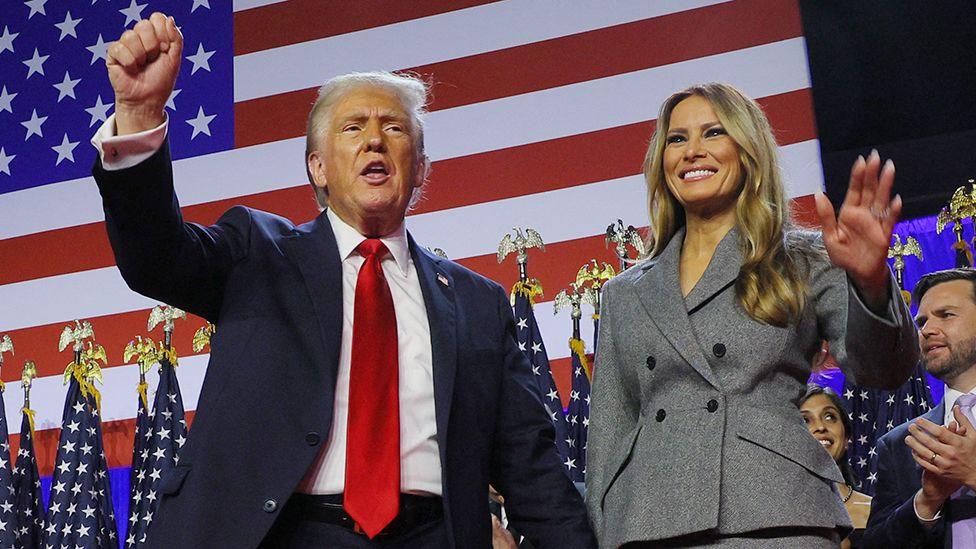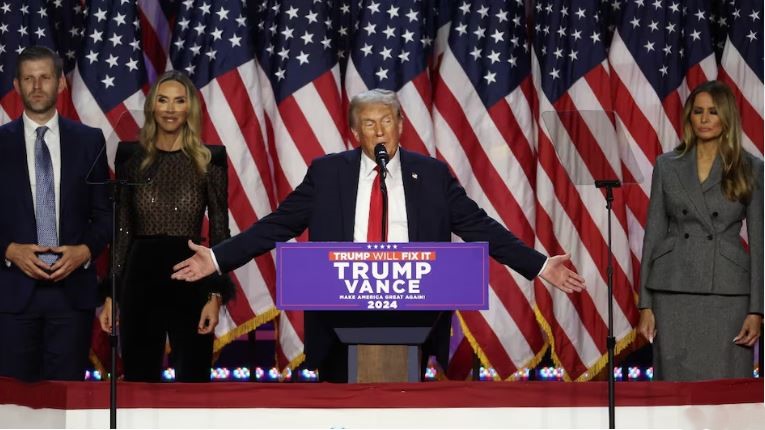Donald Trump has reclaimed the White House
becoming only the second U.S. president
to do so after being voted out
Research and analysis : Sahir Baloch

In a remarkable political comeback, Donald Trump has reclaimed the White House, becoming only the second U.S. president to do so after being voted out. Trump’s victory speech resonated with themes of economic revival, national security, and a pledge to deliver on the promises that helped him win over voters in key swing states. He emphasized his dedication to restoring American pride and confidence, assuring supporters, “We’re going to bring back the America we know and love. We’ll make it stronger, safer, and more prosperous than ever.”
Current Results and Electoral Landscape
As results stand, Trump’s win is buoyed by decisive victories across the southern states, including North Carolina, Georgia, and a striking swing in Florida, which is now solidly red after years as a battleground state. Trump’s appeal among working-class Americans and the Latino demographic, especially in Florida and Texas, proved to be game-changers. The win signals shifts in the Republican base, with Trump making substantial inroads among Black and Latino men while bolstering his traditional stronghold with rural white voters.

Senate and House Position
Republicans have also gained in the Senate, positioning the GOP with a slight majority, enabling Trump to push forward his legislative agenda. The House remains divided but leans toward Republican control, underscoring a challenging yet manageable landscape for the newly re-elected president.
Key Reasons for Trump’s Victory
Trump’s return to the presidency reflects broader shifts in the American political climate and dissatisfaction with the Biden administration’s handling of certain issues, particularly the economy and immigration.
1. Economic Discontent
Trump tapped into public frustration over inflation, promising relief to households burdened by high costs. Even though inflation had begun to stabilize, Americans had not adjusted to the new price levels. Many voters perceived Trump’s promises of lower prices and energy independence as the answer to their financial strain. While economic fundamentals like job growth remained strong under Biden, inflation’s political impact was a persistent challenge for the Democrats, with Kamala Harris struggling to connect on economic issues.

2. Immigration and Border Policy
The Biden-Harris administration’s reversal of Trump’s hardline immigration policies led to a surge in illegal immigration, which became a significant concern for voters. Despite the administration’s efforts to control immigration rates later in their term, many felt the response was too little, too late. Trump capitalized on this dissatisfaction by promising to secure borders and enforce strict immigration policies, which resonated with voters in southern states, where border security is a priority.
3. Shifts in Voter Demographics
Trump’s appeal broadened within the Republican base, attracting working-class voters and a growing segment of Latino voters, especially in Florida and Texas. His success in Miami-Dade County and areas with large Cuban and Puerto Rican populations marked a departure from previous Democratic strongholds. This shift suggests that Trump’s messaging on jobs, economic nationalism, and anti-socialism struck a chord with diverse communities concerned about security and economic opportunity.
4. Strategic Strength in Rural and Swing States
Throughout his campaign, Trump dominated rural regions, where his support was both deep and enthusiastic. In states like Indiana, Kentucky, and Pennsylvania, he not only maintained his base but also expanded margins, setting records in areas where Republicans traditionally perform well. His success in urban areas, particularly among suburban voters in regions like Loudoun County in Virginia, hinted at weakened Democratic influence in suburban swing areas. This eroded Democratic margins in crucial districts, reinforcing Trump’s gains.

The New Face of the Republican Party
Trump’s influence has reshaped the Republican Party into one defined by economic nationalism and isolationism, moving away from its previous stance as the party of free trade and global intervention. Now, Trump hails tariffs as a key economic tool and has distanced the U.S. from international conflicts, promoting a vision focused on domestic issues. This transformation has positioned the Republican Party as a voice for working-class Americans and economic resilience, contrasting with the Democratic platform, which struggled to gain momentum on these fronts.
A Showman’s Controversial Campaign Trail
True to his style, Trump’s campaign was marked by controversies and unscripted remarks. From comments about immigration that were criticized as inflammatory to his unapologetic stance on politically charged topics, Trump broke conventional norms, focusing instead on appealing directly to voter concerns. Despite criticisms from Democrats, he maintained strong support by highlighting issues such as job security, border control, and traditional values.

Looking Forward: A Changed Political Landscape
As Trump prepares to enter his second term, he solidifies his legacy as a transformative figure in U.S. politics. His win is a testament to his ability to connect with voters on issues they prioritize, like economic security and immigration. With the Senate in Republican hands and a divided House, Trump’s administration will likely focus on delivering the changes he has promised, reinforcing his status as a consequential political figure.
In his closing remarks, Trump promised, “This is only the beginning. Together, we’re going to make America greater than ever.” His victory represents a pivotal moment in American politics, signaling a shift toward a redefined Republican Party and a country ready for another chapter under his leadership.






















